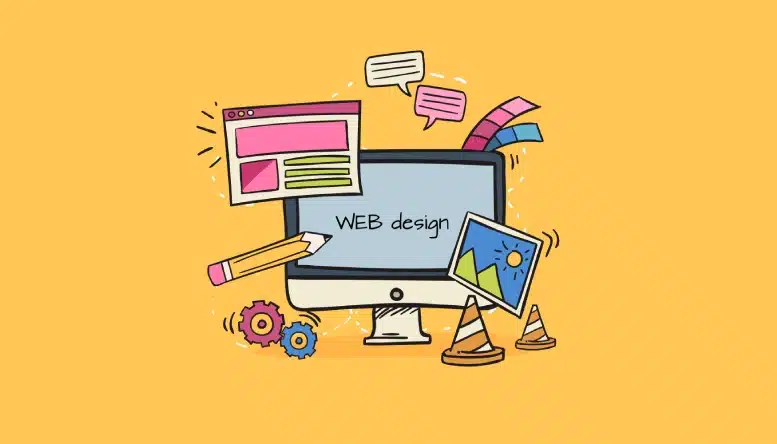The Value of User Experience in Reliable Web Design Approaches
User experience (UX) acts as a keystone in effective web design strategies. It forms how customers engage with a site, influencing their satisfaction and likelihood of returning. A properly designed UX can boost interaction with instinctive navigation and receptive designs. Nevertheless, ignoring these aspects might cause frustration and increased bounce prices. Understanding the details of UX is necessary for designers intending to create compelling electronic experiences that resonate with varied audiences. What variables really drive effective user engagement?
Recognizing User Experience and Its Effect On Design
Although user experience (UX) is usually viewed as a plain aspect of web design, it basically shapes just how individuals interact with a web site. UX encompasses all aspects of the user's interaction, including usability, access, and general contentment. A positive UX cultivates interaction, urging users to check out the website and return in the future. Alternatively, an unfavorable experience can bring about disappointment, leading to high bounce rates and lost opportunities for conversion.
Style elements like content, layout, and navigation company play vital roles fit this experience. Efficient UX design anticipates user requirements and preferences, guaranteeing that information is quickly available and visually enticing. Additionally, comprehending user actions through analytics can provide useful understandings, educating style choices that improve functionality. Eventually, a detailed understanding of UX allows developers to develop web sites that not only attract users yet additionally advertise significant interactions that align with organization goals and user assumptions.
Trick Concepts of Efficient User Experience
Reliable user experience hinges on a number of essential principles that boost web site performance and involvement. User-friendly navigating layout, responsive layout basics, and the importance of aesthetic power structure are essential aspects that add to a smooth interaction in between customers and web content. Recognizing these principles enables designers to create more available and easy to use digital atmospheres.
Instinctive Navigating Design
When individuals run into a website, intuitive navigation style acts as a crucial portal to their overall experience. Reliable navigation enables users to effortlessly situate the information they seek, boosting their interaction with the website. Trick principles include clear labeling, rational company, and consistent positioning of navigating elements. Tags must be uncomplicated, allowing customers to predict the material they will certainly locate. A well-structured power structure helps customers understand the connection in between various areas, leading them through the site effortlessly. Furthermore, responsive food selections and quickly accessible web links add to a fluid experience throughout devices. By prioritizing intuitive navigation, designers can greatly decrease user irritation and increase interaction, eventually promoting a favorable understanding of the internet site and its web content.
Receptive Design Basics
A well-structured navigation system naturally leads to the need for a receptive design, which is important in today's diverse digital landscape. A receptive design warranties that websites feature effortlessly across different gadgets, including smart devices, desktop computers, and tablet computers. This flexibility improves user experience by allowing material to be visually systematic and quickly accessible, no matter of display size. Key concepts of receptive design consist of liquid grids, flexible photos, and media inquiries, which facilitate excellent watching. Additionally, focusing on touch-friendly aspects boosts interaction on smart phones. By carrying out a responsive format, designers can accommodate customers' needs, lessen bounce rates, and rise involvement. Eventually, a well-executed receptive design cultivates a favorable user experience, encouraging site visitors to explore the web site further.
Visual Hierarchy Importance
Visual pecking order plays a crucial duty in leading customers through a website, making certain that essential info captures their attention. By tactically making use of size, shade, spacing, and comparison, designers can create a clear path for customers to comply with. Larger aspects often draw the eye, indicating their significance, while contrasting colors can highlight phone call to activity. In addition, constant placement and group of related material boost comprehension, making navigating intuitive. Effective use of visual hierarchy not just enhances functionality however likewise supports the overall visual of the site, fostering a positive user experience. When users can quickly determine the most vital information, they are much more likely to involve with the material, causing enhanced fulfillment and interaction with the website.
The Duty of Functionality in Web Design
Usability plays a vital duty in web design, especially through navigating simpleness and adherence to ease of access criteria. Effective navigation improves user satisfaction by permitting site visitors to find information promptly and without effort. Conference ease of access requirements assures that all users, regardless of their abilities, can successfully communicate with the internet site.
Navigation Simpleness
Simplicity in navigation stands as a foundation of efficient web design, greatly influencing user experience. A streamlined navigation system allows users to find information promptly and intuitively, minimizing disappointment and boosting fulfillment. Clear labeling and sensible framework are essential components, directing individuals easily through the web site. Redundant web links or extremely complicated menus can disorient users, causing raised bounce rates. Furthermore, mobile responsiveness needs to be taken into consideration, ensuring navigating stays simple throughout tools. Focusing on important web pages and minimizing mess additionally sustains user engagement. Effective navigation not only fosters a positive experience but also urges customers to discover the website extra thoroughly, ultimately causing greater conversion rates. Hereof, navigation simpleness acts as a vital consider the overall effectiveness of web design strategies.
Ease of access Criteria
User engagement is substantially improved when websites abide by accessibility criteria, making sure that all individuals, no matter their capacities, can navigate and connect efficiently. Compliance with these criteria not just expands the target market however also enhances general user complete satisfaction. Available design integrates features such as text alternatives for images, keyboard navigation, and sufficient color comparison, which help with use by individuals with handicaps. On top of that, carrying out these requirements can favorably affect seo (SEO) by boosting site framework and quality. As web design develops, focusing on ease of access comes to be necessary in fostering a comprehensive electronic atmosphere. By welcoming these standards, designers add to a more equitable web, ultimately driving user commitment and engagement.
Significance of Responsive Layout for User Engagement
As consumers increasingly accessibility sites via a variety of devices, the relevance of receptive design ends up being paramount for engaging users efficiently. Responsive design guarantees that a website adjusts effortlessly to different screen sizes, supplying a perfect viewing experience despite the device used. This flexibility improves user interaction by assisting in much easier navigation and interaction with content.
When users encounter a site that is responsive, they are much more likely to remain longer, explore even more, and return in the future. A well-designed responsive layout decreases the aggravation commonly related to scrolling and zooming on smaller sized displays, consequently minimizing bounce prices. Additionally, receptive style can positively impact online search engine positions, as search engines prioritize mobile-friendly internet sites. In today's electronic landscape, where mobile usage proceeds to increase, implementing responsive style get redirected here is not simply helpful, but important for maintaining user involvement and guaranteeing a favorable experience across all tools.
Enhancing Load Times for Better User Contentment

To enhance tons times, internet developers should prioritize enhancing pictures, leveraging browser caching, and reducing HTTP demands. Additionally, employing Content Shipment Networks (CDNs) can speed up material delivery by distributing it across different geographical areas. Streamlining code, such as compressing CSS and JavaScript documents, even more adds to quicker loading speeds.
Ultimately, a commitment to improving load times not only increases user satisfaction yet additionally reinforces brand commitment and boosts the likelihood of repeat check outs. A swift, seamless experience is necessary for maintaining customers and promoting favorable interactions.
The Influence of Visual Pecking Order on User Communication
Visual power structure functions as a vital aspect in directing user communication on an internet site. By arranging material in such a way that prioritizes details visually, developers can affect exactly how customers navigate and involve with a site. This power structure is established via different layout strategies, including size, shade, comparison, and spacing. Larger typefaces or strong shades draw focus to important elements, such as telephone calls to activity or headlines, while suppressed colors and smaller sized fonts can suggest subordinate information.
Reliable visual pecking order aids users swiftly identify what is most vital, decreasing cognitive load and improving usability. It permits instinctive navigation, making it less complicated for users to discover what they need without disappointment. As users communicate with an internet site, a well-structured visual hierarchy promotes a more enjoyable experience, ultimately causing greater engagement and conversion rates. Developers have to prioritize these principles to produce a effective and user-centered web setting.
Measuring User Experience: Methods and devices

Regularly Asked Questions
How Can I Improve My Website's User Experience on a Spending plan?
To boost an internet site's user experience on a budget, one can optimize web page load rate, simplify navigation, apply responsive design, boost material clarity, and collect user comments for constant refinements, making over here sure a gratifying site visitor experience.
What Are Typical User Experience Blunders to Stay Clear Of in Web Design?
Typical user experience errors go to this website in web design include messy layouts, poor navigating, sluggish packing times, lack of mobile responsiveness, ignoring access, inconsistent branding, and failing to focus on user responses - Web Design services. Each can considerably prevent total website performance
How Typically Should I Update My Website for Better User Experience?
Internet sites must be upgraded on a regular basis, ideally every few months, to maintain optimal user experience. Frequent updates aid address use problems, refresh web content, and adjust to transforming user requirements, ensuring the website stays relevant and interesting.

Can User Experience Influence SEO Rankings on My Internet site?
User experience can substantially affect search engine optimization rankings, as online search engine focus on websites that offer smooth navigation, quick packing times, and engaging content. A favorable user experience can bring about reduced bounce rates and greater search visibility.
What Function Does Availability Play in User Experience Style?
Access plays an essential duty in user experience style by ensuring that all individuals, no matter abilities, can browse and engage with a site efficiently. This inclusivity enhances general fulfillment and interaction amongst varied users.
User experience (UX) is usually perceived as a mere facet of internet design, it basically shapes exactly how individuals connect with a web site. User engagement is considerably boosted when web sites adhere to accessibility requirements, making sure that all customers, regardless of their abilities, can browse and connect effectively. Measuring user experience (UX) is vital for comprehending just how successfully a website fulfills the needs of its users. Additionally, use screening, where actual customers navigate the website while observers note problems, provides direct responses on user experience. Typical user experience errors in internet design consist of chaotic formats, bad navigation, slow packing times, absence of mobile responsiveness, disregarding ease of access, inconsistent branding, and failing to focus on user feedback.